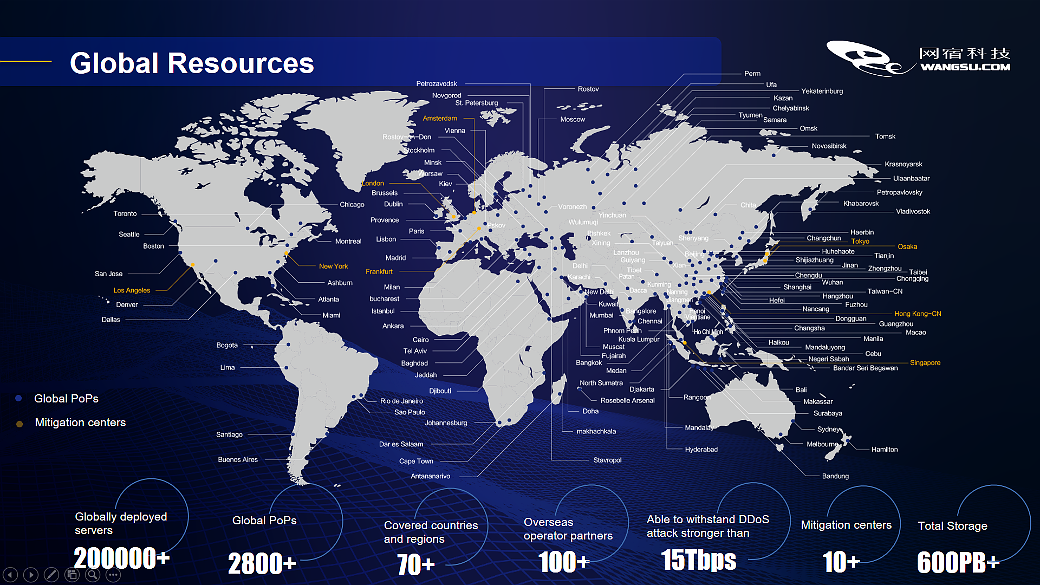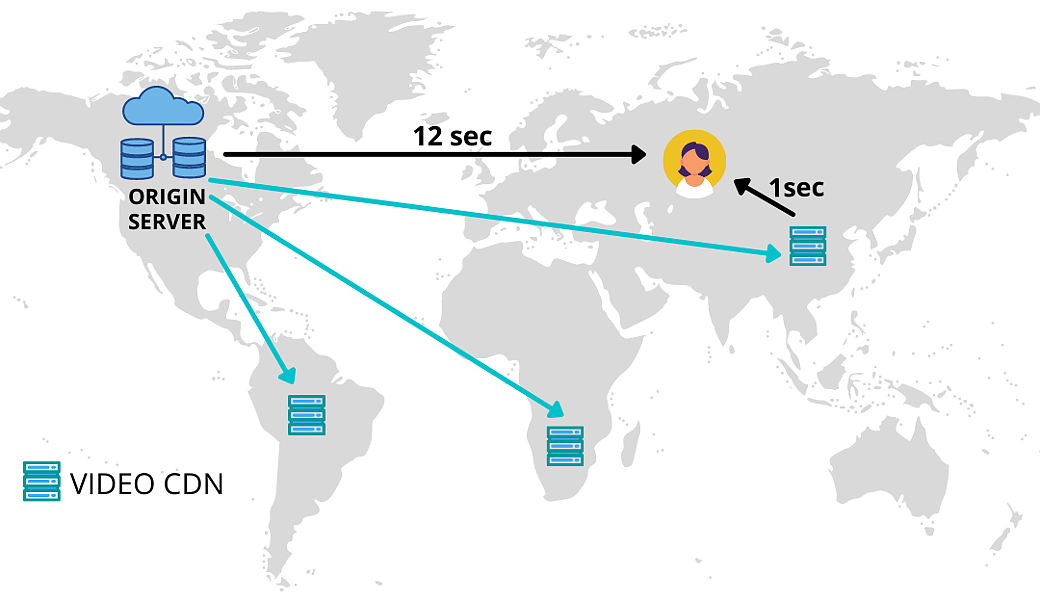Video conferencing, remote work, and staying connected with the employees, business peers, and family members via video chats are the new normal. Whether you watch a video on the internet or just visit a website, a CDN is involved. Your computer sends the request to the server asking for more content that you are browsing through. A CDN hosts the information on a local server so that you can extract the data with ease. In a digital shift like this, CDNs are ramping up content delivery to ensure accessibility for all with efficiency.
CDN is the first priority for all online streaming platforms. Due to the efficiency of the CDN, most news websites, and online stores deliver content faster, and efficiently. With CDNvideo you will have a smooth video streaming experience with high-quality pictures and buffering. That’s the reason why many start-ups and businesses use CDNvideo for global content delivery.
Video is a data-intensive format and requires decent-sized servers for its delivery. Due to this, there is a higher demand for CDN. The world’s internet traffic from CDNs is projected to reach 252 EB per month in 2022.
In this article, we will explain what is video CDN, how it is easing up video content delivery in a rapidly growing digital world, and how you can make the most of it.
Let’s get started.
What CDN is used for in a VOD (Video on demand)?
As its name suggests a Video CDN is the process of delivering video content to the users. It’s that simple. A CDN efficiently delivers content despite hardware failures, slow internet, and other technical issues. Technically speaking, it is a combination of services that are located in different geographical locations and data centers.
CDN refers to the network of geographically dispersed servers that store, cache and transfer the media files. As a result, the video is easily streamed to the end-user from the nearest server.
Here is an example,
If you want to stream video from Europe to China, and if you are using a CDNvideo rather than its original server it will be streamed from the nearest server. As a result, there will not be any buffer delays or slow loading speeds, and the end-user will have a seamless video experience.
How does CDNVideo work?
CDNvideo ensures a reliable, fast, and secure content delivery. Once requested, any query related to content/on-demand video is directed to the nearest server making the whole process quicker and faster. The lesser the distance between the user and the server the quicker the query is addressed.
The overall mechanism of CDNVideo
Here’s how the overall mechanism of the CDN video works. Since a CDN routes the request to the nearest edge services, it prevents the original server from being overwhelmed and reduces the burden due to too many requests.
It also minimizes the exhausting network bandwidth. The overall mechanism of the CDNvideo is similar for both on-demand and live streaming. It caches the files in multiple servers rather than being dependent on only ensuring seamless failover.
For example, if you are in the UK watching a video from a server that’s located in Asia, you will face latency. However, if you have an edge server, the problem will be solved. And, if the server is located somewhere in your own city the video will load far quicker as it will be fetched from the nearest distance where it has been cached.
CDNVideo Storage
CDNvideo storage is the place for storing any file. The page is logically divided into two major parts, there is a top menu and then there is a list of directories.
To access the storage page, go to the media page under which you will find storage. Once you have the access to the dashboard you will not be able to find storage, click on the initialized button to access storage.
You can store 5 GB of data in the CDNVideo storage in its free version.

CDNvideo DVR for live streaming
A great feature of CDNvideo DVR is, that it allows the viewers to pause, rewind, or continue live stream. Once the viewer resumes playback, the live video will quickly resume from where they pressed the pause button.
In order to record the stream, go to the dashboard and click on “DVR and stream recording” it allows you to pause, rewind and continue live streaming.
For each of the streams that you would like to generate you have to choose either short-term broadcast or continuous broadcast.
You will find the following settings in short-term broadcast recordings:
- Stream recording options button;
- Recording storage time and path;
- Timeout;
- Recording start method.
Once you upload your resources into the dashboard you can easily record a stream. You can easily manage the recording by going to the repository.
In CDNvideo the recording is often in m3u8 files which are later converted to MP4 and when it’s off there is no DVR.
CDNvideo TVplaylist(Fakelive)
CDNvideo Fakelive (Or TVplaylist) is one of the great features that strictly restricts the Fakelive options and tricks the console into thinking it is live, when it is not really live. It ensures everything is in real-time, thus restricting any parties that would try to get your content and make the viewers fool by fake live streams.
CDNvideo Content protection MD5/DRM system
CDNvideo heavily focuses on content protection. Once the user requests authorization is done exclusively on the CDNvideo network. None of the external resources are used. The content owner has to create a special reference for the user who requests the content. It contains authorization parameters for content protection.

The basic mechanics of the CDN functionality is caching. It is the process of storing copies of the same data on different servers in different proximities so that it is easier to access. Let’s see how the overall mechanism of the CDN video works.
Building Blocks of CDN
Points of presence (PoPs) are the basic building blocks of the CDN infrastructure which are the data centers in each geography that are responsible for communicating with the nearest users.
The points of presence are wholly responsible for the overall content delivery, connection optimization, and caching. These are the data centers that improve the overall performance of the content making it more reliable, and faster by cutting down on round trip time.
CDNvideo and Storage solution
A video CDN is a hosting platform that allows businesses and enterprises to store video files in the cloud. It seamlessly shares videos with the users and organizes content with ease. CDNVideo enables the broadcasting of the video to a large audience in real-time. It hosts both the on-demand video content and live streams, therefore it goes beyond the basic stream features.
In some cases, a user opts for making their own video broadcasting solution which is a thorough process. In order to make their own video broadcasting customer needs a storage server that would cache images, audio clips, & videos.
Maintaining a server is more costly than using a CDN server for video broadcasting. It implies that websites using shared hosting will have common resources with other websites on a single server. It is thus cost-friendly & efficient.
If a customer uses a regular server instead of a CDN server, he has to follow the following steps to broadcast video:
- He has to convert MP4 into HLS + distribute the content;
- Find compatible player;
- He will have to skip these both steps if he uses a CDN server like CDNVideo.
Users will also need a transcoding server that would convert one form of media into another. It includes a decoding of already compressed, and then somehow altering and recompressing it.
They can use software like OBS/VMIX, Wowza, FFMPEG, and Flusonic. The great thing about Wowza, FFMPEG, and Flusonic is they can be used for transcoding/distribution.
Why CDNVideo
CDNVideo enables its customers to have HTTP acceleration, content access authorization, and unique customization and offers free 24/7 premium support. It also provides HLS live streams by offering optimization for the HLS option. Together, this makes CDNVideo a great choice.
Therefore, instead of building their own solution, users prefer to use CDNvideo services. So that they do not have to worry about storage issues, conversion of the video, and transcoding it. It allows the users to broadcast videos without buying a dedicated server or having no experience in setting them up. Once a user requests a ready-made HTML5 player is provided to stream the video, they can add to the web page easier.
Transcoding is a computationally-intensive process that requires businesses to have powerful hardware resources that include faster acceleration capabilities. It is often done by using a live transcoder that includes a cloud-based streaming platform.
CDNVideo’s transcoding service allows the user to have an adaptive stream for different devices & screens. It is available for all those businesses that lack the ability to live stream with the following features:
- protocol: RTMP, RTSP, MPEG_TS;
- video codec: h.264;
- audio codec: AAC/mp3.
Transcoding allows businesses to live stream with specific parameters, and allow them to reduce the cost of hardware and software.

Benefits of using CDN for streaming video
Efficiency, security, and quality are just a few to name. Below are some of the great benefits of CDN.
Page Speed Load
CDN delivers content with low latency. A CDN passes the local network and speeds up the streaming process to the view on time.
Quality
CDN delivers high-quality videos with a minimal lag time this is important, particularly during the times when people have a very short attention span.
Security & DDoS attacks
Enterprises and businesses are full of confidential information. A CDN provides an extra layer of quality, minimizes security attacks, and avoids informational breaches.
Decrease server load
Since it is distributed around the world, it can reduce the server load by caching your site’s static content. It offloads the data from your original server thus reducing the overall load. CDN also minimizes the makes Round-trip time (RTT) which is the time taken for the content to travel from server to browser.
This is particularly helpful in DDoS attacks when attackers aim to overwhelm a DNS server by sending a large volume of requests. Their main goal is to bring the server down along with the website which brings economic losses to businesses, damages the reputation, and leads to more attacks and hacks. In such cases, CDN acts as DDoS protection and a mitigation platform and distributes the load to protect the data centers and distributes the load throughout the entire network.
Reduce bandwidth and cost savings
A CDN sits between the central server and the rest of the internet therefore it cuts the traffic between them. As a result, it also minimizes the data transfer costs. Since the main server is no longer responsible for delivering the same content again and again, it decreases the bandwidth cost.
It serves up cached content so that the original server doesn’t have to deliver the same content over and over again.
Having a CDN in place might cost you but it can help you save on monthly data transfers that typically outweigh the overall cost of using a CDN.
Video transcoding
CDN helps with an enhanced streaming experience as it allows the broadcasters to convert their media files to make their videos viewable across multiple devices and platforms.
Increase Audience Reach and Scale Effectively
A CDN provides a great user experience, low risk of attacks, and better performance benefitting the businesses to grow at scale and reach global audiences seamlessly.
The system is backed by a dedicated team and you don’t have to worry about delays in content delivery to your target audience. The team looks after the content delivery and provides a great user experience. It keeps the audience satisfied with its snowball effect and accelerates its expansion allowing the businesses to scale into the new market.
How to choose the best video CDN Provider?
Choosing the right CDN is important because it’s how your business is going to give a great user experience.
Let’s look into the 3 top rules for choosing the right CDN for your business.
Rule #1 – Should have the largest network, size, and distribution
The more servers your CDN has, the faster you will be able to deliver content, hence the system will be reliable. It translates to more scalability, great redundancy & less buffering. You should also pay attention to the geographical distribution as CDN in some locations are robust and others have fewer features to give your audience a seamless experience.
Rule # 2 Robust customer support
Always choose a CDN provider that is easy to work with. Great customer support goes a long way when it comes to choosing the right CDN service provider. Consider CDN provides that:
- Has a team of experts and in-house tech support;
- Available support 24/7;
- Seamless customer support via email or chat.
Rule # 3 affordable prices
Transparent and affordable pricing is what everyone should look for when choosing a CDN because so many providers have hidden charges that you can’t compromise with. It’s great to choose a certain CDN that provides custom contract pricing, and you can choose its bandwidth depending upon your needs.
Look for a CDN that offers control over various aspects, including edge logic, access control, failover behavior, performance optimizations, cache keys, and cache rules.
Customized and flexible and it has a network in place that supports functionality.
Same experience, different geography!
Final thoughts
The attention span of the customers is decreasing and it’s less than 8 seconds today. And if the video loads slowly, or keeps buffering it will increase the bounce rate. This is due to latency, which is the central distance a web request travels from being made to the web page being delivered.
A CDN decreases latency to provide an efficient solution to the end-user. While this perfectly works for the on-demand video, the process is similar for live streaming. CDN caches the video segments that are created in real-time, and instead of previously created videos. Rather than directly from the stream’s origin, the stream is served to the users from a cache.
In times like these, it’s important to provide seamless video streaming and a demand video experience to the user. Pick a video streaming provider that’s efficient after all, a better user experience is the key to business success. Choosing the right CDN enables fast delivery, and smooth video playback for the viewers no matter where they are located in the world.
Choosing the right infrastructure is important for shaping the quality of the product identity. Because a CDN is closer to the end-user than the original server, it cuts down the round trip time, providing quick results.



